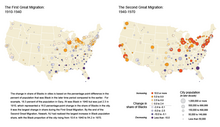
Back الهجرة الكبرى الثانية (الأمريكيون الأفارقة) Arabic Segunda Gran Migración Afroamericana Spanish Bigarren Afro-amerikar Migrazio Handia Basque Seconde Grande migration afro-américaine French Seconda grande migrazione afroamericana Italian Друге Велике Переселення (США) Ukrainian


In the context of the 20th-century history of the United States, the Second Great Migration was the migration of more than 5 million African Americans from the South to the Northeast, Midwest and West. It began in 1940, through World War II, and lasted until 1970.[1] It was much larger and of a different character than the first Great Migration (1916–1940), where the migrants were mainly rural farmers from the South and only came to the Northeast and Midwest.
In the Second Great Migration, not only the Northeast and Midwest continued to be the destination of more than 5 million African Americans, but also the West as well, where cities like Los Angeles, Oakland, Phoenix, Portland, and Seattle offered skilled jobs in the defense industry.[2] Most of these migrants were already urban laborers who came from the cities of the South. In addition, African Americans were still treated with discrimination in parts of the country, and many sought to escape this.[1]
- ^ a b "In Motion: African American Migration Experience, The Second Great Migration". Archived from the original on 2007-04-16. Retrieved 2007-03-18.
- ^ II, Codis Hampton (2015-10-23). Remembering Moz: Gracie & John Hampton's First-Born. Outskirts Press. ISBN 9781478766056.